Female Pattern Baldness & PRP Treatment
It’s a condition that is whispered about in hair salons, but it’s rarely spoken about in public. Yet, female hair loss is an issue that millions of women face, and it affects nearly 50% of women in their lifetime. Female hair loss can be caused by changes in hormones, a shock to the body, or even repeated hairstyles. Hair growth and appearance can be an incredibly intimate part of a person’s identity, and hair loss can deeply impact the way that we feel about our looks.
Female pattern hair loss (FPHL), also known as female androgenetic alopecia or androgenic alopecia, can affect around 40% of women by age 50. This is caused by a reduction in hair volume, combined with hair shedding from resting hairs. FPHL can be a frustrating condition for many women, particularly those with early signs of thinning hair.
Overall, female pattern hair loss is very different than male pattern baldness in how it appears. Male pattern balding is usually noticeable via a receding hairline or bald patch atop the head, forming an “m”-shaped pattern, but females do not generally follow a particular pattern. Within FPHL, hair shedding is more evenly distributed, though it can often begin with hair thinning along the top of the head, as well as a widening part line. For many, it may be their part getting wider, but for others, it may be thinning hairs near their temples that are seen first – generally, the thinning is more widespread than for males.
There are several options for the treatment of androgenetic alopecia, but up until recently, the treatment options have felt less-than-perfect for many patients. There are topical treatments, such as daily topical minoxidil (Rogaine), which can be tiresome and lead to inconsistent results. There are also medications, such as oral finasteride, which can be effective but are often contraindicated for women. Additionally, hormonal medications like birth control or Spironolactone can often be effective for women. Still, daily medication is not always a good fit for a patient and can have potential side effects.
Thankfully, recent research in the world of dermatology has led to discoveries in hair restoration. Studies have shown that platelet-rich plasma treatment, or PRP injections, is an effective way to improve new hair growth and hair thickness. The use of PRP for treating hair loss uses your blood to apply stimulating growth factors to the scalp, using a centrifuge to separate red blood cells from stimulating white blood cells and platelets that are vital for regenerative treatments within the body. PRP therapy requires virtually no downtime and can help to stimulate increased hair count and hair growth at and around a PRP injection site, creating a healthy head of hair.
Dr. Michele Green is an internationally renowned board-certified dermatologist and expert in treating hair loss with over two and a half decades of experience providing some of the world’s most discerning individuals with customized hair restoration treatment plans. As one of the first NYC dermatologists to offer platelet-rich plasma therapy to her patients with hair loss and thinning, she has helped countless men and women achieve their hair restoration goals. She is consistently identified as one of New York’s best dermatologists by Castle Connolly, Super Doctors, and New York Magazine for her dedication to her patients and expertise. If you’re frustrated by thinning hair or female pattern hair loss, board-certified dermatologist Dr. Michele Green is here to help. Contact our New York City office today to develop your custom hair restoration treatment plan.
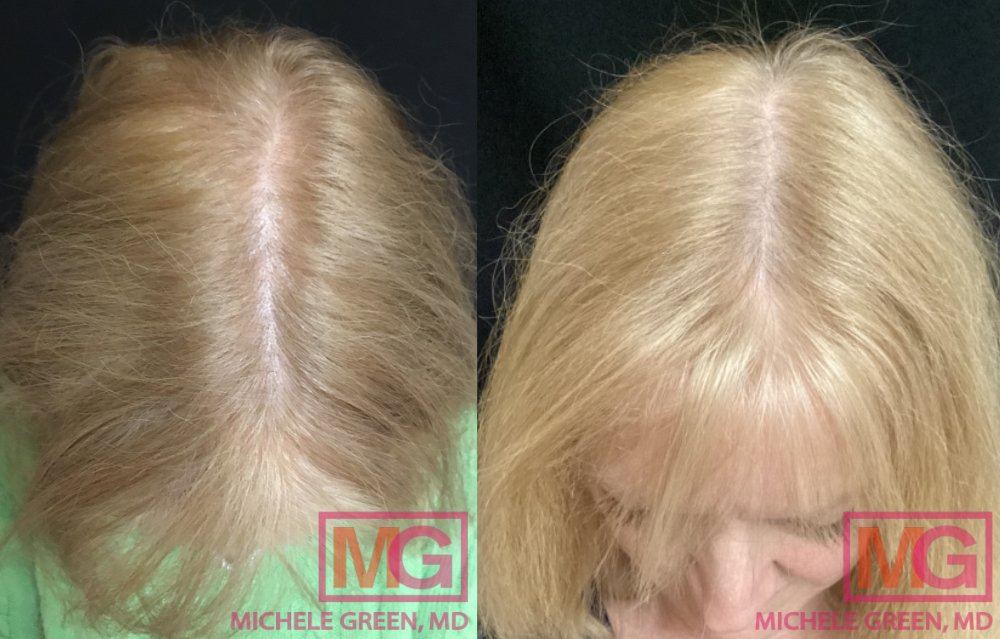
What causes female pattern hair loss?
Genes for FPHL can be inherited from either parent, but unlike male pattern baldness, androgens are not the only reason for female pattern baldness or ‘female androgenetic alopecia.’ Androgens are hormones that play a significant role in both hair growth and sexual function. For some women, an increase in androgens, testosterone, can be the cause of hair loss. In others, it can be caused by a decrease in estrogen levels. FPHL is more common after menopause, suggesting estrogens may also have some more direct relationship.
The natural hair growth cycle has four primary stages: anagen, catagen, telogen, and exogen. During the anagen stage, the hair grows. During the catagen stage, the hair undergoes a simple transitional phase that lasts a little over a week. In the telogen stage, the hair no longer grows, typically lying dormant in the hair follicle for a few months. Then, in the exogen stage, the hair falls out, leaving space for the cycle to repeat. In the case of female pattern hair loss, instead of the cycle starting anew, the hair shedding is permanent, and the hair follicle does re-enter the anagen stage.
This process of female pattern hair loss can occur at any point and can occur in patients as young as 20 or more, typically into the 40’s and 50’s. Hair loss may also occur in phases, meaning it may happen for a few months and then reoccur at a later date. In addition to cosmetic issues, it can cause mental health and wellness issues, interfering with daily activity through feelings of depression or unattractiveness.
Many other factors cause hair loss, such as stress and nutrition. For instance, low iron levels (anemia) can cause hair to thin, while vitamins can boost hair growth. Temporary hair thinning can also occur in females due to childbirth, illness, menopause, or sudden changes in diet, so it is important to know if PRP is the right solution for you.
As similar conditions to female pattern hair loss can be caused by stress or hormonal issues, it is important to discuss potential hair loss influences with Dr. Green prior to initiating treatment. There are several hair loss treatment options available for women who suffer from thinning hair or hair loss due to other factors, and Dr. Green can help to work with you to develop the best hair regrowth plan for you.
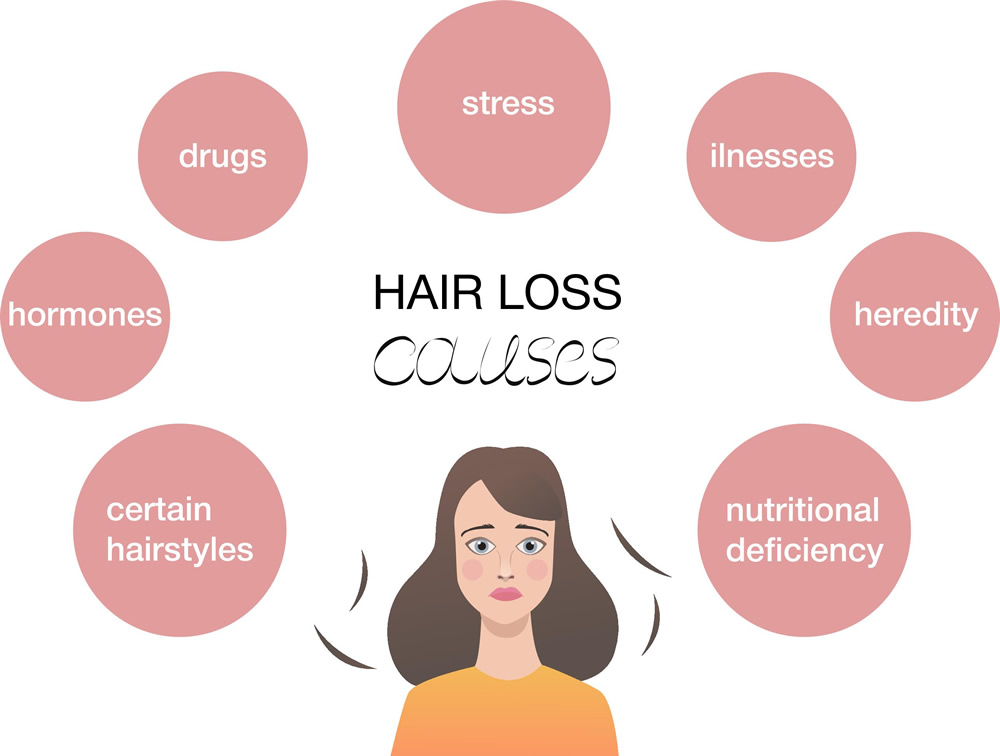
How effective is Platelet-Rich-Plasma (PRP) for hair growth?
PRP is highly effective for helping both male and female patients with hair loss. According to multiple studies published in journals such as the Journal of Cosmetic Dermatology, Aesthetic Plastic Surgery, and the International Journal of Women’s Dermatology, the effectiveness of PRP therapy indicates it is a promising treatment option for hair restoration. Improved hair growth, hair count, and hair thickness have been shown in patients who experience both alopecia areata (spot baldness) and androgenetic alopecia. Though PRP is not an effective treatment for all causes of thinning hair or hair shedding in women, it has been shown to improve hair quality at or near the PRP injection site for patients with female pattern hair loss, as well as several other forms of hair loss.
In 2019, a systematic review of PRP therapy for hair restoration was featured in Dermatologic Surgery, which looked at 19 investigative studies that observed PRP treatment for hair loss in 460 people. This review demonstrated that the studies overwhelmingly reported hair regrowth in patients with both androgenetic alopecia and alopecia areata when treated with PRP injections. It’s considered to be a promising treatment for hair loss. However, it’s good to note that the studies thus far have used varying PRP treatment preparations, session intervals, and techniques, so not all PRP hair restoration treatments are created equal. Dr. Green is an expert in anti-aging dermatology and PRP therapy and can, therefore, offer you a treatment option that is both effective and safe.
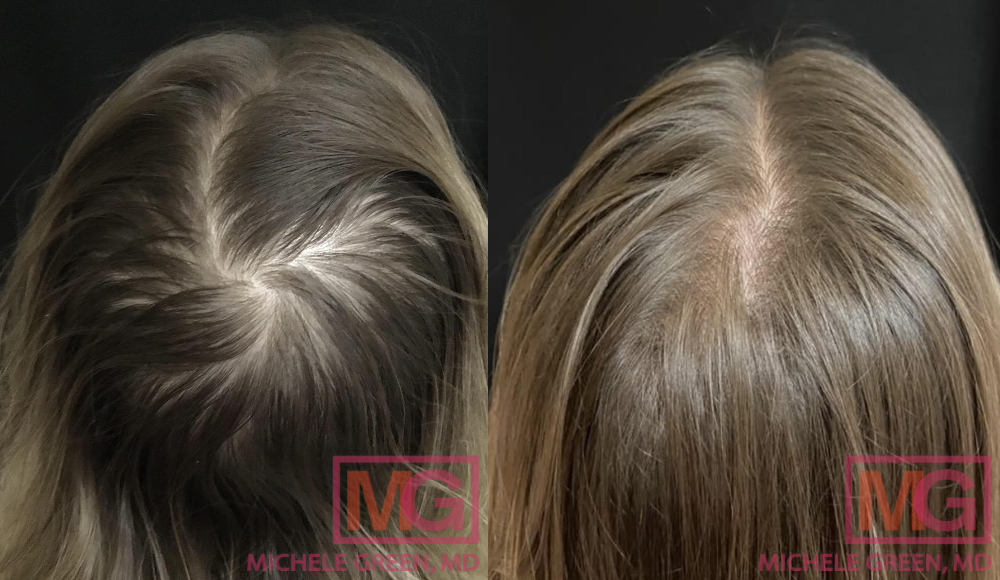
6 months before and after PRP treatment
Will PRP stop hair loss?
Yes! With many patients, PRP injections will help stop their hair loss. On average, patients who receive approximately three PRP treatments over 3-4 months are able to see improved hair growth that reverses the signs of hair loss in patients with androgenetic alopecia. In fact, according to a study on PRP therapy for hair growth over one year released by the National Institutes of Health, PRP injections caused an increase in hair density. They created overall hair restoration satisfaction in over 70% of participants.
PRP hair restoration should not be considered a cure-all for hair loss, and typically, patients will engage with maintenance PRP treatments in order to continue new hair growth and hair thickness. The number of PRP treatments for optimal results depends on the individual needs and aesthetic goals of each patient. Currently, there is no total cure for either androgenetic alopecia or alopecia areata, and alternative treatments such as Rogaine or oral finasteride require continued daily maintenance. For these reasons, PRP therapy is considered an excellent alternative to daily medications or topical treatments.
How does PRP work for women’s hair loss?
If you’re wondering how PRP works for women’s hair loss, the process is simple. First, you’ll meet with Dr. Green for an initial consultation to discuss your hair loss symptoms and determine which treatment will be best for you. If PRP therapy is recommended, the PRP injection treatment is quite simple. First, a standard blood sample size is taken and put through a centrifuge. The centrifuge is able to separate the different components of your blood, intensely concentrating the platelets within your blood into a platelet-rich plasma that has three times the standard amount of growth factors. As the PRP solution is made up of components from a patient’s own blood, there are very few risks associated with the serum itself.
A topical anesthetic solution can be prescribed by Dr. Green and applied to the affected areas of the scalp one hour before the platelet-rich plasma injections to reduce any potential discomfort during the procedure. Dr. Green will inject the PRP into target areas of the scalp where hair loss is most acute. The process, in total, takes about a half hour, and you can continue with normal activity post-treatment, though it’s best to wait until the next day to wash your hair/scalp.
PRP treatment for hair restoration does vary amongst medical professionals. Still, Dr. Green’s procedure for PRP is tailored to maximize hair growth in healthy individuals experiencing thinning hair, hair shedding, and hair loss. Patients typically engage in three treatments spaced 4-6 weeks apart, and results continue to develop over several months following treatment. If PRP is an ideal match for hair regrowth, then patients can engage in maintenance treatments spaced at either the six-month or one-year mark.
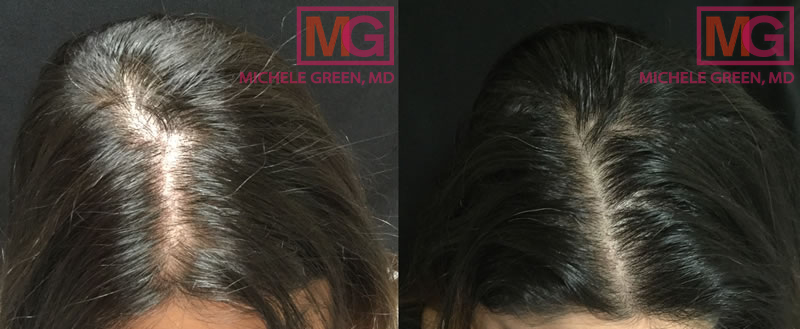
34 year old female, PRP to scalp for hair loss – after 3 treatments
What Types of Alopecia Does Platelet-Rich Plasma Treat?
Platelet-rich plasma injections are an effective treatment option for several types of hair loss, including telogen effluvium, alopecia areata, and androgenetic alopecia (female pattern baldness). Telogen effluvium is characterized by temporary hair loss due to extreme shock or stress to the body. The hairs are pushed into the resting (telogen) phase for two to four months before they fall out. The next hair growth (anagen) phase does not begin. A few months after the occurrence of the stressful event, these hairs fall out. Clinically, telogen effluvium presents as diffuse hair thinning, often which is particularly noticeable after washing hair.
Alopecia areata is an autoimmune disease that causes the immune system to attack healthy tissues, including hair follicles. Alopecia areata typically presents as distinct areas of patchy hair loss on the scalp. However, this type of alopecia can also affect other areas, such as the eyebrows or beard. Alopecia areata has the potential to progress to total hair loss. Both men and women can be affected by this disease, and most cases occur in patients younger than 30 years of age.
Female pattern baldness, also known as androgenic or androgenetic alopecia, is characterized by a widening part and diffuse hair loss. Like male pattern baldness, female pattern baldness is linked to genetic and hormonal factors. A sensitivity to androgen hormones can cause the hair follicles to weaken, which reduces the length of the anagen phase of the hair growth cycle and lengthens the exogen phase. A board-certified dermatologist like Dr. Green in NYC can work with you to diagnose the type of hair loss you have and develop a personalized treatment plan for promoting new hair growth.
Are there any side effects to PRP treatment?
PRP hair restoration for female pattern hair loss is a new use for PRP therapy, and according to published studies over the past few years, PRP treatment can improve hair growth with minimal side effects. Common side effects include minimal discomfort or soreness at the injection site. Occasionally, patients may experience swelling, headache, itching, or temporary bleeding at the injection site. Though downtime is minimal post-treatment, Dr. Green recommends avoiding exercise immediately following treatment and steering clear of alcohol consumption or smoking for a minimum of 3 days. In order to make sure that PRP treatment is safe for each patient, Dr. Green assesses previous medical history, as well as the nature of any hair loss.
As platelet-rich plasma uses a blood sample from the patient, a medical professional must oversee these PRP injections. There have been known to be severe side effects when platelet-rich plasma has been derived in a non-medical environment, including in a medical spa context. This is why Dr. Green conducts all patient consultations and procedures herself for PRP hair restoration treatment in her private NYC dermatology office. The safety and satisfaction of Dr. Green’s patients are her top priority.
Is PRP for hair loss worth it?
For those who are struggling with female pattern hair loss and who are either contraindicated for or disinterested in daily oral medications or topical treatments, PRP for hair loss is an excellent option. Dr. Green is experienced in PRP treatment for hair growth, and her patients have seen remarkable improvement in the look and feel of their hair. It’s a wonderful treatment option that requires no downtime and can lead to long-term hair restoration.
PRP has optimal results anywhere where hair loss has occurred, but the hair follicle is not dormant. This means that PRP, also known as telogen effluvium, can be particularly worthwhile for those who are experiencing early hair loss or are struggling with resting hair loss. This type of hair loss can be common after pregnancy or due to a stressful or traumatic experience, such as a car accident or intense emotional stress. For some, this kind of hair loss is only subtly noticeable, if at all, but for others, resting hair can account for almost 60% of hair count. In these instances, hair regrowth treatment may be needed to restore fullness, and platelet-rich plasma treatment can be ideal for restoring a healthy head of hair.
What hair restoration treatments are available?
While there is no set cure for female pattern hair loss, various treatments are available. These include topical treatments such as minoxidil (Rogaine), which unfortunately can come with unpleasant side effects like hair growth in other areas and weight gain. There are also other common medications for FPHL, such as oral finasteride (Propecia), flutamide, or dutasteride. In terms of non-invasive cosmetic procedures for hair growth, patients can look to laser treatment or platelet-rich plasma (PRP) therapy. When you meet with Dr. Green, she will work with you to consider all possible options for hair growth treatment and to determine which treatment option is best for you.
Should I do PRP for hair loss?
The best way to determine whether you are a good candidate for PRP treatment for hair loss is to consult an experienced expert, such as board-certified dermatologist Dr. Michele Green. At her private dermatology office in Manahattan’s Upper East Side neighborhood, she will work with you to determine the potential underlying factors contributing to your hair loss or thinning and develop an appropriate treatment plan. Remember, the earlier that you start with hair loss treatments after noticing signs of thinning hair, the more likely you are to observe hair regrowth as a result of treatment.
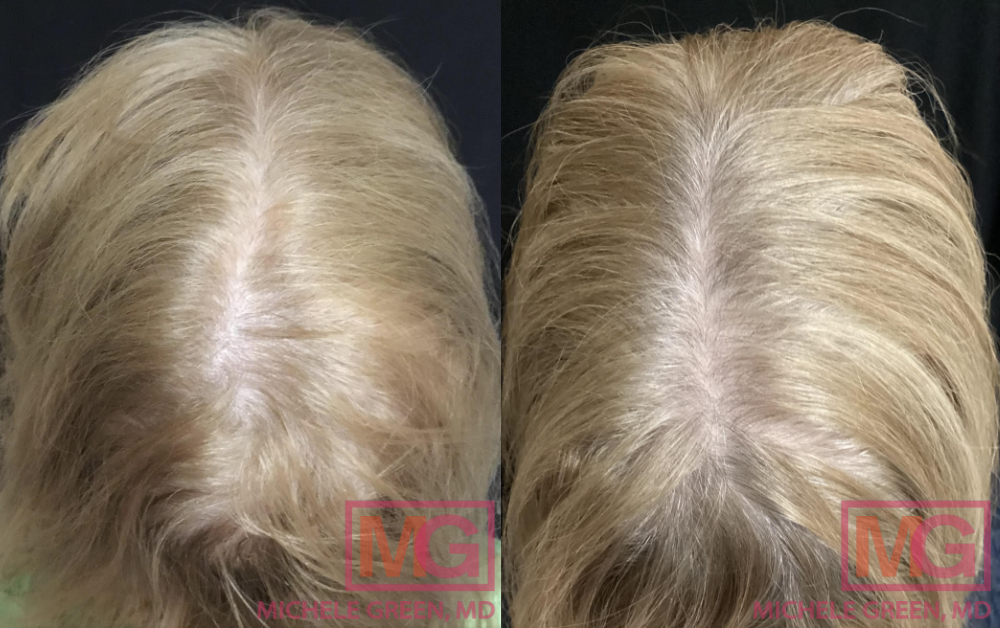
Is PRP good for female hair loss?
PRP therapy is a cutting-edge hair loss treatment option that is effective in treating and managing various types of hair loss, including female pattern baldness. Many studies are beginning to show how effective PRP treatment can be at helping to trigger growth factors and stem cells that promote hair regrowth and stop hair thinning as a result of androgenic alopecia, telogen effluvium, and alopecia areata. For patients who may be wary of more intensive processes, such as a surgical hair transplant, the accessibility of the minimally invasive, injectable PRP treatment is appreciated.
What is the downside of PRP injections?
Platelet-rich plasma injections are an excellent treatment option for hair restoration that utilizes the patient’s growth factors. Many patients appreciate the accessibility of PRP as a non-invasive hair loss treatment option compared to a surgical hair transplant, which requires an invasive procedure, extended downtime, and can have many side effects. PRP provides patients with a non-invasive option to help regrow their hair, and it is safe to use in conjunction with other oral medications and topical treatments.
Some patients note that what they find to be the most challenging aspect of PRP treatment is waiting for the visible results, as hair restoration is a process that takes some time. While many patients begin to see results after just a couple of PRP treatment sessions, it can take up to six months for the full results to be observable. Although PRP produces gradual results, patients agree that the hair restoration benefits of the cosmetic procedure are well worth it! To maximize your results and ensure that your hair is thicker, fuller, and healthier for longer, it is important to consult with an experienced board-certified dermatologist, such as Dr. Michele Green in NYC, as soon as you notice signs of hair thinning or loss. An expert like Dr. Green can work with you to determine the potential underlying factors contributing to your condition and develop a personalized treatment plan to address it properly. The earlier you begin with hair restoration and loss prevention treatments, the more likely you are to benefit from treatment.
What happens if PRP goes wrong?
One of the biggest benefits of PRP is that it involves utilizing the growth factors derived from a sample of the patient’s own blood. This means that there is very little risk of encountering unwanted side effects. In fact, most patients don’t experience any side effects aside from mild swelling and discomfort at the injection sites, which resolve quickly after the procedure is done. The effectiveness of PRP treatment has also been demonstrated for several types of hair loss, including androgenetic alopecia, telogen effluvium, and alopecia areata, meaning that most patients who are deemed good candidates for the procedure will achieve some hair restoration benefits. Of course, individual results will vary depending on the underlying factors contributing to the hair loss and the severity of the condition. It is always recommended to consult a hair loss expert, such as Dr. Michele Green in New York City, to determine whether you are an appropriate candidate for PRP before undergoing treatment.
How does PRP work for hair?
Platelet-rich plasma treatment relies on the high concentration of protein growth factors in human plasma, which are involved in the body’s natural wound healing process and, when injected into affected areas of the scalp, improve the blood supply of the hair follicles and increase the thickness of the hair shafts. These qualities of PRP make it exceptional for nourishing the health of hair follicles, pushing the hair from the rest phase into the active growth phase, and ceasing shedding.
Does PRP work for women’s hair loss?
Yes! Clinical trials have demonstrated that platelet-rich plasma therapy is a promising treatment option for several types of hair loss, including telogen effluvium, androgenetic alopecia, and alopecia areata. PRP is a safe and effective treatment for hair restoration when it is performed by an experienced medical professional, such as board-certified dermatologist Dr. Michele Green in New York City. Many patients benefit from engaging with multiple hair loss treatment options simultaneously. When you consult with Dr. Green, she will collect a thorough medical history and physically assess the condition of your hair loss to determine whether you are a good candidate for PRP injections and which other hair loss treatment options you may benefit from.
Can I get PRP while pregnant?
It is not recommended to have platelet-rich plasma therapy while pregnant. Instead, it is advised to wait until after childbirth to have PRP treatment. While PRP is objectively safe, there are several reasons that it is not recommended during pregnancy. Although the risk of encountering side effects, such as an allergic reaction or infection at the injection sites, is incredibly rare, there are few safe treatment options for such occurrences when pregnant. Additionally, the PRP treatments themselves can be uncomfortable, and no topical anesthetic solution can be used safely while pregnant to minimize discomfort. Lastly, hair loss and thinning hair are common during pregnancy, and waiting to have PRP treatments until after pregnancy can help with post-partum hair restoration. If you are experiencing hair loss or thinning during pregnancy, schedule a consultation with board-certified dermatologist Dr. Green, who can help you develop a post-partum hair restoration treatment plan.
How does female PRP hair treatment work?
PRP treatment begins with a standard blood draw to collect a sample, which is required to derive the serum for injection. The blood sample is spun in a centrifuge to separate the plasma from the red blood cells. The platelet-rich plasma contains a high concentration of growth factors that have many medical and cosmetic benefits. In fact, platelet-rich plasma injections are also often used in orthopedic medicine to treat sports injuries, as well as for cosmetic purposes, like as a topical serum during a microneedling procedure for facial rejuvenation. When injected into affected areas of the scalp, the platelet-rich plasma boosts the health of the hair follicle. It pushes hair into its growth phase, contributing to greater hair density. To ensure safety and efficacy, only a certified medical professional, such as board-certified dermatologist Dr. Green in NYC, should administer PRP injections.
How long does it take for PRP to work? When can I see PRP hair regrowth results?
While individual results may vary, most patients observe some improvement after just a couple of PRP treatments. However, it can take three to six months for the final visible results. Of course, rejuvenation results will vary depending on the nature of hair loss and the desired results of each patient. When you have PRP treatment with Dr. Green at her private dermatology office in Manhattan’s Upper East Side neighborhood, she will assess your progress on a monthly basis. Photographs will be taken and stored in your private medical record to track your hair restoration progress, and Dr. Green will adjust your hair loss treatment plan as necessary. Maintenance PRP treatments may be recommended depending on your rejuvenation results and hair loss condition.
How often should I do PRP for hair loss?
Most need a short initial series of four PRP treatment sessions, each spaced approximately four weeks apart, to attain optimal hair restoration results. While individual results may vary, most patients observe some improvement after just a couple of PRP treatments. However, it can take three to six months for the final visible results. Patients are asked to return to Dr. Green’s private dermatology office in NYC three months after their initial series of four PRP treatments. At this time, Dr. Green will evaluate the progress and work with you to establish a timeline for regular maintenance treatments. Many patients have PRP on a quarterly, bi-annual, or annual basis to continue stimulating the growth factors and stem cells involved with promoting the rejuvenation benefits of platelet-rich plasma therapy.
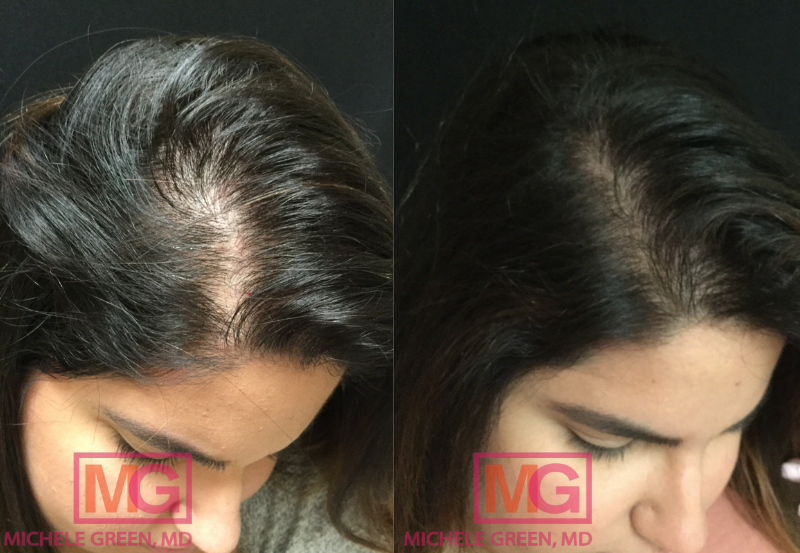
37 year old female, PRP for hair loss – after 6 months
How to get started with female PRP hair treatment today
Overall, there are many causes of female pattern hair loss, and it is important to discuss options and get an accurate diagnosis from a board-certified dermatologist beforehand. Many conditions with hair loss look similar but require different treatment methods. Additionally, there are a few patients who are contraindicated for PRP for hair loss, such as those who suffer from thyroid disease or autoimmune disorders that lead to continued hair loss. Lastly, those who are currently taking blood thinners will be poor candidates for PRP therapy, as their blood samples won’t have the levels of platelet concentration needed for proper hair restoration. A good candidate for PRP therapy is someone who suffers from female pattern hair loss and is seeking treatment to reverse the signs of hair shedding or hair loss.
If you’re frustrated by thinning hair or hair loss, there’s a solution that can finally help. Dr. Michele Green is an international expert in hair loss with over 25 years of experience treating some of the world’s most discerning individuals and was one of the first dermatologists to incorporate PRP treatments into the customized hair restoration plans of her patients in her NYC boutique practice. She is consistently identified as one of New York’s best dermatologists by Super Doctors, New York Magazine, and Castle Connolly for her dedication to her patients and expertise. Find out today how to delay female pattern hair loss and reverse hair loss with PRP treatments by contacting Dr. Green to schedule a consultation at (212) 535-3088 or contact her online.
 212-535-3088
212-535-3088